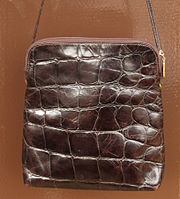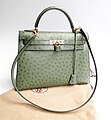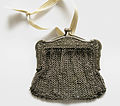purse
The handbag is a clothing accessory that can consist of different materials and is carried as a handle bag in the hand or over the arm, on a longer or lengthened strap over the shoulder (shoulder bag). In recent times, depending on the purpose and shape of the bag, terms such as shopper , weekend bag , baguette , clutch , pochette and messenger have become established. The medieval belt bag has also returned, and backpacks now fall into the handbag category as well. Since the 1980s, handbags have also been worn by men at times.
story
In the Middle Ages, bags made of fabric or leather were attached to belts, initially only by men. In the 15th and 16th centuries, women also wore bags that hung from chains or straps from their belts. In the 16th and 17th centuries, pouch-shaped bags appeared, but were worn less often. One or two little pockets hidden under the wide skirt that could be reached through a slit in the skirt were more common. This type of pocket - also sewn onto the petticoat - was common for a very long time and can still be found on traditional dresses today.
In the 18th century the pompadour was part of fashionable clothing. The accessory , also known as Ridikül , was a bag mostly sewn from silk without a solid bottom, which could be closed at the top with two strings, which then served as a handle or shoulder strap. The fashion of the Directoire, with its ever narrower and more transparent robes, finally made the use of the handbag inevitable, because the bags could no longer be placed under the clothes as before.
19th century
By 1805, the women who wore the bodice as outerwear had finally established themselves, and no one left the house without a handbag. The metal frame was invented in 1846, so that the handbag subsequently differed significantly from its bag-shaped predecessors and gained greater practical and fashionable importance. When heavy-duty bags with handles that you could take with you on trips were in demand, the first handbags were made from leather. These bags looked more like a small suitcase and for the first time had a snap lock. At the end of the 19th century, the handbag finally became an accessory for women.
20th century
After the First World War, leather was scarce and expensive, so that even well-known fashion houses tried their hand at cotton fabrics. At the same time, the proportion of synthetic materials used increased extremely in the 1920s. The zipper adopted from the Canadian Army's transport sacks became socially acceptable in 1923. The minimalist designed pouches (pochettes) experienced a fashion high point, which, according to their models from the 18th and 19th centuries, had a flap similar to an envelope. The well-known bags with the shape determined by a frame were also fashionable. There were also exotic-looking dance bags and mesh bags made of metal links, some of which were decorated with fringes at the bottom. Handbags made of metal links have been around since the early 18th century, but they remained extremely rare because of the laborious handwork and only became affordable for the general public after the introduction of the first machine for the production of metal mesh in 1908.
In the course of the 1930s, bag design gradually changed, and the geometric shapes and patterns of Art Deco gave way again to a more playful and sometimes ostentatious and artistically high-quality design. This included, for example, silk appliqués as well as artistic velvet and chenille embroidery, and clasps and hangers became more and more elaborate and exotic. Due to the declining purchasing power of the population, however, manufacturers increasingly resorted to plastics such as celluloid or Bakelite . Forearm bags were still one of the preferred models; Evening bags with antique motifs in muted hues were all the rage. At the end of the 1930s, the bags got bigger and the shoulder straps longer. Shoulder bags and shoulder bags gave the wearer a "free hand". With large bags made of linen and synthetic materials, the manufacturers responded to the increasing opportunities for leisure activities for large sections of the population.
In the 1950s, along with the money for the economy, the USA also brought modern materials such as nylon , PVC and synthetic leather , which were to have a decisive influence on the image. The handbags mostly had an angular profile in this decade. In addition to tapering frame handbags with a wide base, all sorts of box-shaped and box-shaped containers with handles, hangers or loops determined the fashion. Another answer to the leather shortage were the spacious basket bags made of straw and bamboo from Italy, which also caused a sensation in America. The handbags for the elegant lady became smaller and more delicate again; Pompadours with loops and forearm pockets as well as case pockets for the evening were in vogue.
From the 1970s and 1980s, fashion designers such as Schiaparelli , Pierre Cardin , Paco Rabanne , Yves Saint Laurent , Gianni Versace , Judith Leiber , Paul Smith , Alexander McQueen , Lulu Guinness and Tom Ford began alongside their prêt-à-porter collections To create handbags; and well-known brands such as Gucci , Hermès , Chanel , Dolce & Gabbana , Donna Karan , Miu Miu , Chloé and Fendi offered handbag collections in addition to their fashion collections.
Since the Washington Convention on Species Protection of 1976, reptile leather goods can only be manufactured with proof of legality. Against this background, the International Reptile Leather Association (IRV), founded in 1972, developed the species protection flag as a species protection identification system for reptile leather goods, which has been recognized by the federal authorities since 1987 as proof of legality for goods which are flawless under species protection law and which is a reliable alternative to the CITES verification regulation.
The restrictions in reptile leather processing led leather goods manufacturers to develop embossing methods that make the surface of cowhide look like a crocodile skin.
Colorful shoulder and shoulder bags with wide belts made from used truck tarpaulin have been a success since the 2000s . The bag body, which is closed with a flap with Velcro, can also be stabilized with webbing. In the large main compartment there are various small compartments for today's indispensable utensils such as EC cards, pens and cell phones.
Picture gallery
Kelly Bag (since 1935)
Birkin Bag (since 1984)
Doll handbag ( bag maker-journeyman's piece from the 1950s)
See also
- Ridikül
- Pompadour
- bag
- Hendrikje Pocket Museum
- World handbag throwing championship
- The woman with the handbag
literature
- Meyer's Encyclopedic Lexicon . Bibliographical Institute, Mannheim / Vienna / Zurich 1973, without ISBN, Volume 11, p. 410.
- Valerie Steele, Laird Borelli: handbags . DuMont-Verlag, Ostfildern 2001, ISBN 3770185226 .
- Anna Johnson, Eri Morita: Handbags: The Power of the Purse , Workman Publishing, London 2002. ISBN 0-761-123-776 .
- Ellen Goldstein-Lynch (et al.): Making Handbags: Retro, Chic, Luxurious . Rockport Publishers, New York 2002, ISBN 1-564-968-499 .
- Annette C. Anton: The handbag. Eichborn Verlag, Frankfurt / Main 2003, ISBN 3-821-839-937 .
- Emma Bowd Emma: Beloved bags . Artea Verlag, Munich 2004, ISBN 3-933-861-586 .
- Kathryn Eisman: Crazy about handbags . Kabel Verlag, Munich 2004, ISBN 3-822-506-583 .
- Margret Fiebig-Drosten (Ed.): Constant companions. Handbags and their history (published as Volume 16 of the series of publications by the Historical Museum of the City of Aurich) Cloppenburg 2006, ISBN 978-3-938061-19-0 .















